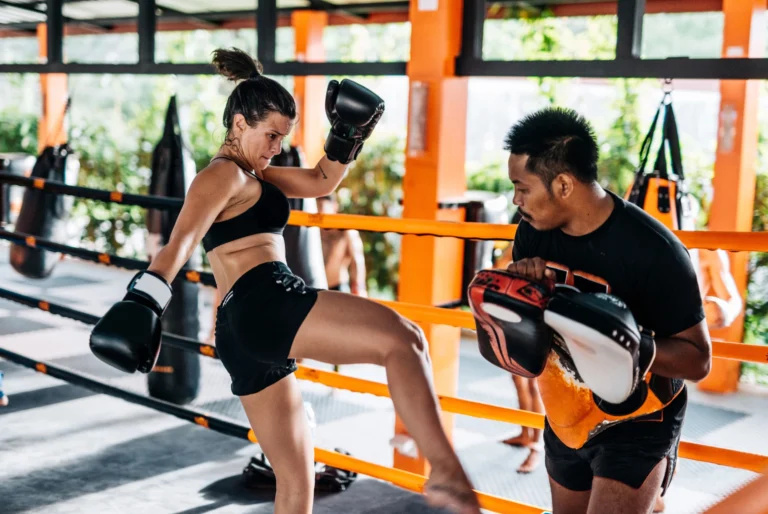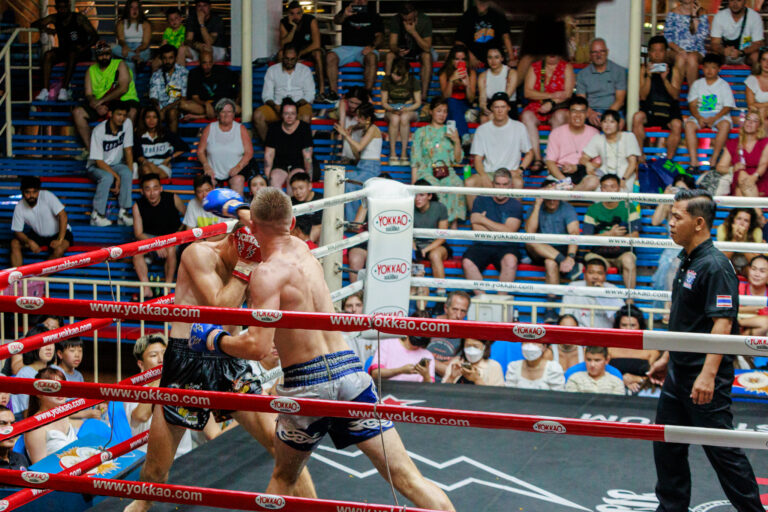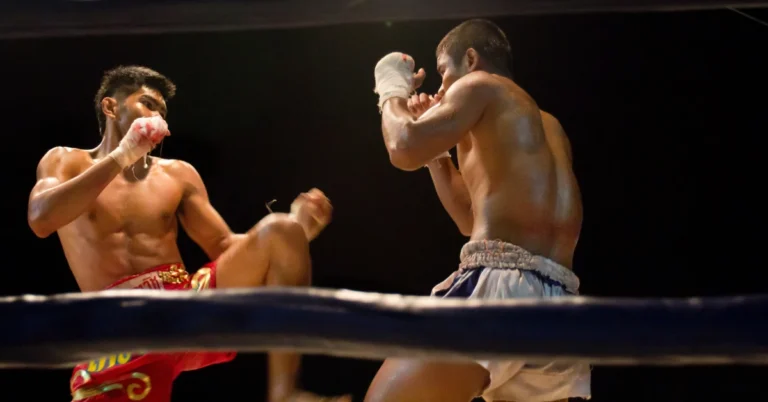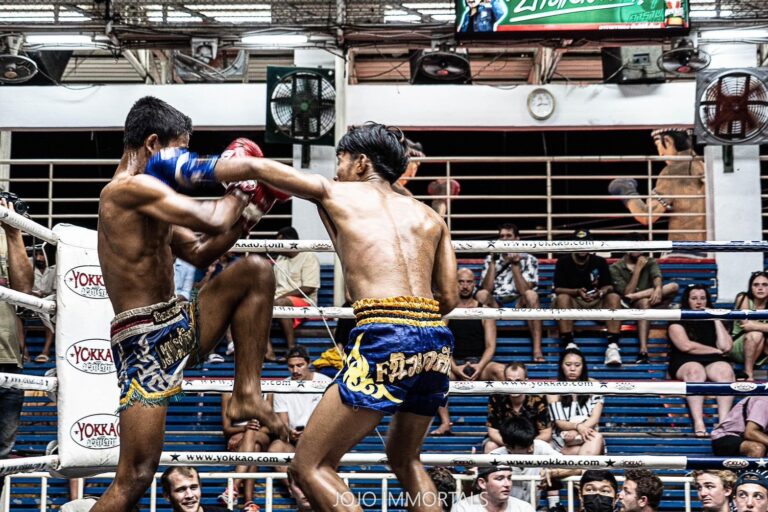Self-defense remains a primary motivation for martial arts training, with Muay Thai and boxing representing two highly effective striking systems. Both disciplines develop physical capabilities, mental toughness, and practical skills applicable in threatening situations. The choice between these arts depends on individual preferences, physical attributes, and specific self-defense concerns.
Understanding each system’s strengths and limitations helps practitioners make informed decisions about training investments. Real-world confrontations differ vastly from sport competition, requiring consideration of multiple factors beyond ring effectiveness. This comprehensive analysis examines how Muay Thai and boxing translate to self-defense scenarios, providing clear insights for those seeking practical protection skills.
Muay Thai for Self-Defense: The Eight-Limb Advantage
Muay Thai offers comprehensive striking options that address various self-defense situations through its complete arsenal of weapons.
Versatile Striking Arsenal for Real Situations
The art of eight limbs provides defenders with fists, elbows, knees, and shins as striking tools, creating options for every distance and angle. Elbow strikes prove particularly effective in self-defense, requiring minimal space while delivering devastating cutting and knockout potential. These techniques work excellently when attackers close distance aggressively or in confined spaces where full punches become impossible.
Knee strikes offer another powerful defensive tool, especially effective against charging opponents or when grabbed. The straight knee to the solar plexus can immediately incapacitate attackers, while curved knees target ribs and liver with fight-ending force. Thai kicks create distance management options, with the push kick (teep) maintaining space and the roundhouse kick delivering stopping power to legs, body, or head. Low kicks to attackers’ thighs quickly compromise mobility, potentially ending confrontations without escalating to head strikes.
The variety means defenders adapt to situations rather than forcing specific techniques. Against multiple attackers, kicks maintain distance while strikes discourage approach. In confined spaces, elbows and knees provide close-quarter options. This adaptability proves invaluable when adrenaline affects decision-making and situations evolve rapidly.
Clinch Control and Close-Quarter Defense
Muay Thai’s clinch system provides crucial skills often overlooked in self-defense discussions. Real confrontations frequently involve grabbing, pulling, and wrestling for position. The Thai plum position, controlling an opponent’s head with both hands, enables defenders to land knee strikes while maintaining balance and control. Sweep techniques from the clinch put attackers on the ground while defenders remain standing, a significant tactical advantage.
Clinch training develops specific strength and balance that translates directly to self-defense. Practitioners learn to maintain composure when grabbed, using attackers’ aggression against them through redirection and off-balancing techniques. The ability to fight effectively while being held prevents panic in close-quarter situations. Regular clinch sparring creates familiarity with the pressure and claustrophobia of being grabbed, building confidence for real encounters.
Boxing for Self-Defense: Refined Hand Striking
Western boxing’s focused approach creates different self-defense advantages through specialized development of punching and defensive skills.
Precision Punching and Defensive Movement
Boxing develops hand speed and accuracy beyond other martial arts, creating the ability to end confrontations quickly with well-placed punches. The jab serves multiple defensive purposes – maintaining distance, disrupting attackers’ vision, and setting up power shots. A solid cross delivers knockout power, while hooks and uppercuts prove devastating at close range. This specialization means boxers develop intuitive punching combinations that flow naturally under stress.
Defensive boxing skills translate exceptionally well to self-defense. Head movement patterns – slipping, rolling, and weaving – help avoid wild punches common in street fights. The shoulder roll and high guard provide protection while maintaining vision and counter-punching opportunities. Footwork patterns create angles for escape or attack, with lateral movement particularly useful for avoiding linear charges. These defensive reflexes, developed through countless hours of practice, activate automatically in threatening situations.
Practical Simplicity Under Stress
Boxing’s limited technique selection becomes advantageous when adrenaline affects motor skills and decision-making. Rather than choosing between multiple weapons, boxers focus purely on hand strikes that feel natural to most people. This simplicity reduces hesitation and analysis paralysis in high-stress confrontations. The sport’s emphasis on combination punching creates automatic responses to openings, valuable when conscious thought becomes difficult.
Training methodology emphasizes practical application through extensive mitt work and sparring. Boxers become comfortable operating under pressure, taking hits while maintaining composure and returning fire. This pressure testing builds genuine confidence different from theoretical knowledge. The conditioning developed through boxing – both cardiovascular and mental – ensures practitioners maintain effectiveness even as confrontations extend beyond initial exchanges.
Range and Situational Effectiveness
Understanding how each art performs at different ranges helps predict real-world applicability.
Multiple Distance Management in Muay Thai
Muay Thai provides tools for every conceivable distance in confrontations. Long-range kicks keep aggressive attackers at bay while assessing situations. Medium range allows full utilization of punches and kicks, providing maximum options for defense and counter-attack. Close range brings elbows and knees into play, weapons often more effective than punches when space restricts full arm extension. The clinch provides control options when distance collapses completely.
This range versatility means practitioners avoid being nullified by distance manipulation. Attackers cannot simply rush inside to neutralize kicks because knees and elbows await. Conversely, maintaining distance doesn’t guarantee safety against trained kick techniques. The ability to flow between ranges based on circumstances provides tactical flexibility. Environmental factors like walls, furniture, or multiple attackers influence range choices, with Muay Thai offering solutions for each scenario.
Boxing’s Focus on Punching Range
Boxing specializes in the punching range where most untrained confrontations naturally occur. This specialization creates exceptional proficiency within this critical distance. Boxers develop precise distance judgment, knowing exactly when opponents enter striking range. The ability to close distance quickly through footwork, land combinations, and exit safely proves valuable in hit-and-run scenarios.
However, boxing’s range limitations create vulnerabilities. Without kicks, maintaining distance against aggressive attackers becomes challenging. The prohibition on clinch fighting means boxers may struggle when grabbed or held. While boxing footwork excels at creating angles, it doesn’t address situations where greater distance benefits defense. These limitations don’t negate boxing’s effectiveness but require awareness and potentially supplementary training.
Training Considerations and Learning Curves
Practical factors influence which art individuals can effectively develop for self-defense purposes.
Time Investment and Skill Development
Boxing typically offers a shorter path to functional self-defense capability. Basic punching combinations, defensive movements, and footwork patterns develop within months of consistent training. The limited technique selection allows deeper refinement faster, creating usable skills relatively quickly. Most people possess instinctive punching motions that boxing refines rather than completely rebuilds.
Muay Thai requires longer development time due to its comprehensive technique arsenal. Developing effective kicks demands flexibility and conditioning many adults lack initially. Knee and elbow techniques require specific body mechanics different from natural movements. Clinch work involves unique strength and balance development. However, even basic Muay Thai skills provide more options than basic boxing, potentially offsetting the longer learning curve. The variety also maintains training interest longer for many practitioners.
Physical Conditioning Requirements
Both arts demand significant physical conditioning but emphasize different attributes. Muay Thai develops full-body conditioning through varied techniques. Kicking builds hip flexibility and leg strength. Clinch work develops core stability and pulling strength. The constant stance switching and level changes create functional fitness applicable beyond martial arts. This comprehensive conditioning supports overall self-defense capability through improved physicality.
Boxing creates exceptional cardiovascular endurance and upper body conditioning. The sport’s emphasis on sustained output over rounds builds stamina for extended confrontations. Hand speed and shoulder endurance from thousands of punch repetitions create lasting defensive benefits. However, boxing’s leg conditioning focuses on movement rather than striking power, potentially limiting lower body defensive options. Unlike ground fighting arts that require specific flexibility, both Muay Thai and boxing accommodate various body types and fitness levels with appropriate progression.
Real-World Application Scenarios
Examining specific situations reveals how each art’s characteristics translate to self-defense effectiveness.
Street Confrontation Dynamics
Real confrontations rarely resemble sporting contests, involving factors like multiple attackers, weapons, and environmental obstacles. Muay Thai’s kick arsenal proves valuable against multiple opponents, with leg kicks quickly compromising attackers’ mobility. The ability to strike with knees while controlling one attacker’s head provides options when outnumbered. Push kicks create space for escape or assessment, crucial when withdrawal represents the best option.
Boxing’s rapid combination punching can overwhelm single aggressors before situations escalate. The defensive reflexes and footwork help avoid sucker punches and wild haymakers common in street fights. Superior conditioning allows boxers to maintain effectiveness longer than untrained aggressors who quickly exhaust themselves. The sport’s emphasis on timing and distance helps identify openings for decisive strikes that end confrontations quickly.
Making the Right Choice for Personal Goals
Individual factors should guide martial art selection for self-defense. Physical attributes matter – naturally flexible individuals might favor Muay Thai’s kicking techniques, while those with fast hands might excel at boxing. Age considerations influence choice, with boxing’s lower flexibility requirements suiting older beginners. Previous injuries might preclude certain techniques, making one art more accessible than another.
Lifestyle factors affect training consistency and development. Available training facilities, quality instruction, and training partner availability influence progress. Some find Muay Thai’s variety maintains motivation, while others prefer boxing’s focused refinement. Cultural interest might draw individuals toward Muay Thai’s traditional aspects or boxing’s Western athletic approach. The best self-defense system ultimately becomes the one practitioners train consistently and confidently apply under pressure.
Experience Combat Sports Excellence in Phuket
Both Muay Thai and boxing offer valuable self-defense capabilities with distinct advantages and limitations. The choice depends on individual preferences, physical attributes, and specific defensive concerns. While boxing provides refined punching and defensive movement, Muay Thai offers comprehensive striking options for varied situations.
Experience authentic Muay Thai at Phuket’s legendary stadiums – Bangla Boxing Stadium (Monday, Thursday, Saturday) and Patong Boxing Stadium (Tuesday, Friday). Book tickets online for ringside seats to witness the art of eight limbs in action. See firsthand why warriors worldwide choose Thailand’s national sport for self-defense mastery.












